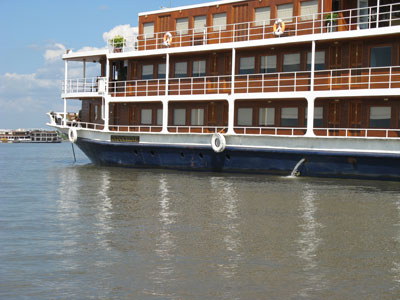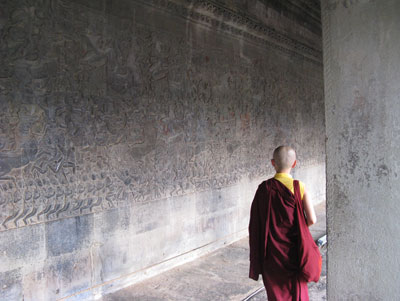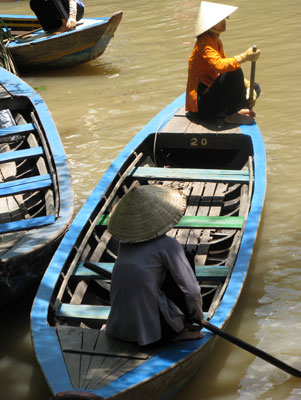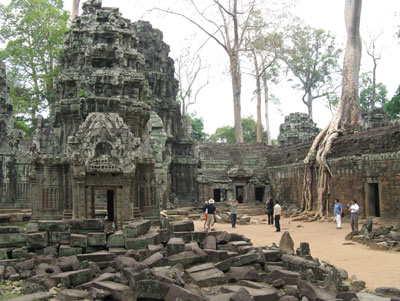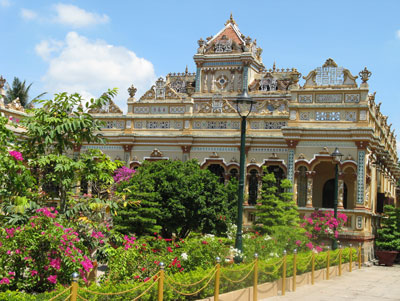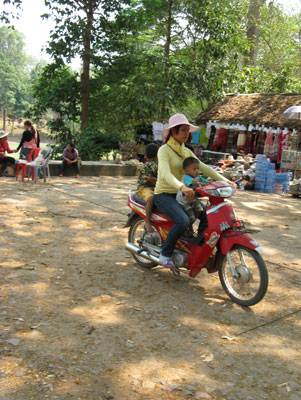Vietnam and Cambodia – Plying the waterways of the Mekong Delta
by Mary Beltran, ITN
I stood on deck, feeling the cool breeze of our passage and realized, again, that river cruising is one of my favorite ways to travel.
I love being aboard a ship and watching the flow of the river and the changing view of the banks as we move by; joining the small group of travelers who form that bond of shared interests; exchanging travel stories at the dining tables, and being welcomed upon my return to the ship at the end of a day’s excursions. I particularly adore the fact that I have to unpack just once during my trip, no matter how many miles the itinerary covers.
This time I was cruising to Vietnam and Cambodia with Value World Tours (Fountain Valley, CA; 800/795-1633, www.rivercruises.net), aboard the RV Indochine.
The Mekong Delta
My March 20-April 2, 2009, “Mekong Delta Cruise” itinerary began in Vietnam’s Ho Chi Minh City (Saigon) and concluded at Siem Reap, Cambodia. After two days touring Ho Chi Minh City and the surrounding area and spending a night on the ship, we began our trip up the delta. We cruised to the Mekong River through an inland canal that allows riverboats connection to the port without having to risk the rough seas of the open ocean.
Our daily excursions fell into a pattern of a 2- to 3-hour morning trip, a return to the ship for lunch and a rest while the ship sailed farther upriver and then a 2- to 4-hour afternoon excursion. Some meals were taken off the ship at local restaurants, providing a nice change of pace and a variety of dining experiences.
This was a fairly new cruise for Value World Tours, so they were still working out their excursion itinerary. While our schedule included a variety of sites, I felt it was a little heavy on visits to Buddhist temples and Chinese pagodas.
I found the two museum visits a little disheartening. Items on display represented only a fraction of the countries’ original wealth, as many artifacts had been stolen or destroyed during war.
An emotional visit
I was fascinated but emotionally disturbed by our visit to the Cu Chi Tunnels in Vietnam. This hand-dug network of tunnels aided the Vietnamese in their guerrilla warfare during the 1960s, and remnants of the underground complex included re-creations of the former schools, kitchens, living quarters, hospitals and military production areas.
Our guide was quite proud of his country’s ability, with limited resources, to fight off a vastly better-equipped military, but also he was careful to express that most Vietnamese people have made their peace emotionally with the Americans, and he held no animosity.
However, the exhibits of traps, weapons and military methods were too graphic for me. It brought home very forcefully the violent death that had occurred on the land that was all around me.
Along the riverbanks
As we traveled up the Mekong, we stopped at many small villages that had no docking or port facilities. The captain maneuvered the ship close to the sandy banks and the crew would leap out to tie ropes to trees or stakes pounded into the ground. Steps chopped into the dirt made it a challenging clamber up the banks, but the crew was always positioned along the path to offer a hand.
This was a very active trip, with a lot of walking on dusty roads and climbing among ruins and up and down many steps. I’m almost 50 and not very fit, so I was puffing quite a bit, but I made it.
The shore stops I enjoyed the most were our visits to local markets teeming with shoppers and small vendor stalls. My supermarket-jaded eyes were delighted with the vivid colors, the crowds and the unusual goods on display. The fish market, with live frogs, eels, snails, squid, etc., was a lot more fun than the glassed counter at my local grocery store.
There were huge displays of locally harvested fresh produce of excellent quality. Much of the country’s rice, fruit and vegetables are grown in the rich delta soil that is replenished annually during the flood season.
I have a special interest in ruins and ancient cultures, so I was happy with the several excursions along the river that focused on wats, temple complexes and bridges from the Chenla Empire and the Angkor period. Many of these ruins were damaged during war, but much remains of their former glory.
In Vietnam as well as Cambodia I saw vivid reminders of the long conflicts that have ravaged both the people and their land. Their economies are struggling and basic services are very slowly being extended into the rural regions.
Although most of the poor island villages we visited had some electricity (from generators), few had clean water sources and there were almost no paved roads in the areas outside town. In town, however, the small lots along the crowded shopping streets were lined with comparatively newer concrete buildings.
On to Cambodia
Our 2-day port call in Phnom Penh, the capital of Cambodia, gave us time to tour the main sightseeing highlights. This bustling modern city, with skyscrapers downtown and the huge Royal Palace complex, was a big change from the small villages along the river. I took a short evening walk along the long riverside promenade lined with shops and restaurants — a favorite activity of both visitors and locals.
Our morning tour, which included visits to the Royal Palace, the Silver Pagoda, a large market and the colonial area, was fun.
In the evening, we took a tuk-tuk ride around the city, but it was still very hot and humid and the exhaust from the tuk-tuks was not very pleasant. Later, we attended a dinner show at a traditional Khmer apsara dance theater. Although I enjoyed the highly stylized dancing and brilliant costumes, the professional dancers looked bored and the food was mediocre.
I much preferred the shipboard show performed by some of the children of a Kampong Cham orphanage that Value World Tours sponsors. The children demonstrated the apsara dances that they had learned in school, and their performance had a style and joy that really charmed me.
The crowning experience of the trip was the day spent at the Angkor temple complex near Siem Reap. In the morning we visited Angkor Thom, Bayon, Baphuon Temple, the Terrace of the Elephants and, at the Royal Enclosure, the Terrace of the Leper King. The sky was, blessedly, overcast, which helped us survive the blistering temperatures. Many days were in the 80s and I was melting in the high humidity.
The Angkor Thom and Bayon temples have enormous fig trees that have overgrown the ruins. As the trees cannot be removed without causing the structures to crumble, they are left in place and are now popular photo locations.
The jumble of fallen rocks and rubble made walking through the ruins tricky and, even with some wooden stairs and raised walkways, we did a lot of climbing up and down on worn steps.
Angkor Wat
After a return to the boat for lunch, showers and a rest, we drove back to the temples to visit the famous Angkor Wat. This temple is in very good condition and was breathtakingly beautiful.
I am always amazed at the evidence of the years of work and the craftsmanship on these types of temples. The carvings that ornament almost every surface, the closely fitted hand-cut stones and the precise alignments of the buildings to match solar and lunar calendars: all of this impressed me enormously.
Angkor Wat is designed like a set of nesting boxes. After crossing a moat on a long stone causeway, we walked through the exterior wall’s gate and over a huge grassy area with reflecting pools. Next we entered a very long gallery that ran along the outside of the temple on all four sides, like a covered porch. I was fascinated with the intricate carvings on its inner walls depicting religious legends and battle stories of the kings.
Moving inward, we entered another encircling hallway with rooms situated under towers and four gates marking the cardinal points. We passed through two more concentric courtyards with several small altar rooms before reaching the central temple standing high above all the other towers.
Visitors can no longer climb Angkor Wat’s central tower, as UNESCO and the Cambodian government have deemed it unstable. (Work was being done to stabilize the structure.) The current plan is to conserve the temple in its present state rather than try to restore or refurbish it.
By going to Angkor Wat in the afternoon, we avoided the traffic jams of the huge morning crowds. We also took advantage of the light of the afternoon’s “magic hour.” When the sky was overcast, the temple walls were gray and black and the lichens stood out in white and green, but when the sun came out the colors warmed to browns and golds and more of the carvings were highlighted.
Shipboard life
This Value World Tours cruise was a charter. The Indochine, a medium-size ship with a capacity of 48 passengers in 22 cabins and two junior suites, had a crew of about 28.
All cabins face outside, each with a window overlooking the river. (The two small suites have sitting areas.)
My cabin was roomy (about 12 by 14 feet), with a private bathroom and twin beds. As a tall person, I really appreciated that the bathroom had a shower under which I could actually stand up, with space to turn around. There was plenty of storage plus all of the usual amenities, including a safe and a hair dryer.
While there was no coffee maker in the cabin, a tea/coffee/water bar was always available on the upper deck’s outside lounge. I think I went through at least two liters of water every day! Fortunately, plenty of bottled water was available at all times for free, and the cabin water bottles were always promptly restocked.
In the extremely hot and humid weather, the cabin’s individually controlled air-conditioning was a big bonus during the nights, but mine did struggle in the afternoons and could not quite overcome the heat.
The wooden paneling, decks and finishes around the ship gave it a “colonial” feel. The ship was built in 2008 but was showing some wear, as the humidity had taken a toll on some of the wooden decking and panels. The ship is scheduled to be refitted with harder woods during its 2009-2010 hiatus.
I found the English-speaking staff to be personable and professional and the service excellent and unobtrusive.
Our cruise manager, Stephan, helped arrange alternatives to the standard excursions for some of the passengers who were unable to navigate the terrain or had a request to do more shopping. During the day, he answered our questions, and his nightly briefings kept us well informed.
The cuisine on board reflected Asian, French and Western influences. I appreciated the high quality of the fresh ingredients and the flavorful sauces. There were full breakfasts cooked to order, ample lunch choices (with several salads) and, at dinner, three choices of entrées, one of them always vegetarian.
We tied up most nights (except for two), so the ship was quiet during sleeping hours, but each morning before dawn I woke in my lower-deck cabin to hear the local fishermen with their noisy little outboard motors leaving for work.
There were very few bugs and mosquitoes on our trip, but I did use plenty of insect repellent because there is a small chance of malaria in the area. The river is mostly clear, but the villages and wooded areas pose a small risk.
While this last cruise of the season was more economical, I would recommend going earlier as the weather would be much more pleasant. Even after two terrific downpours, the humidity and heat stayed high the entire trip. In late March the river was low, and we had to disembark before our last scheduled port and ride a bus into town.
Travel details
I flew on United from Sacramento to Los Angeles and on Asiana Airlines from Los Angeles to Ho Chi Minh City ($1,490 round trip in economy). On my return flight, I had a 9-hour layover in Seoul and was pleased that Asiana took the initiative to arrange a free day room for me with shuttle service from and to the airport.
My cruise on the Indochine was provided compliments of Value World Tours, but I paid all my own fees, including those for the Cambodian border crossing ($35) and a visa for Vietnam ($100), plus taxes, tips and extraneous costs.
The cruise-tour cost for 2010 will range from $3,099 to $3,199, per person double, with departures from January to March and October to December.
Although many land tours of the area are offered, I felt this river cruise provided a unique and pleasant way to experience life along the Mekong.


